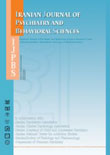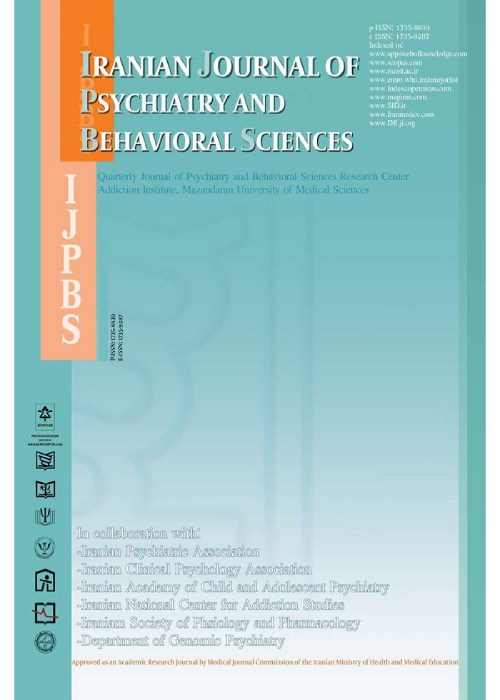فهرست مطالب

Iranian Journal of Psychiatry and Behavioral Sciences
Volume:10 Issue: 1, Mar 2016
- تاریخ انتشار: 1395/02/02
- تعداد عناوین: 10
-
-
Page 1Context: Suicide prevention is a health service priority. Some surveys have assessed suicidal behaviors and potential risk factors.ObjectivesThe current paper aimed to gather information about etiology of suicide attempts in Iran.
Data Sources: Pubmed, ISI web of science, PsychInfo, IranPsych, IranMedex, IranDoc as well as gray literature were searched.
Study Selection: By electronic and gray literature search, 128 articles were enrolled in this paper. Pubmed, ISI web of science, PsychInfo, IranPsych, IranMedex, IranDoc were searched for electronic search. After reading the abstracts, 84 studies were excluded and full texts of 44 articles were reviewed critically.
Data Extraction: Pubmed, ISI web of science, PsychInfo, IranPsych, IranMedex, IranDoc as well as gray literature were searched to find any study about etiologic factors of suicide attempt in Iran.ResultsDepressive disorder was the most common diagnosis in suicide attempters that is 45% of the evaluated cases had depression. One study that had used Minnesota multiphasic personality inventory (MMPI) found that Histrionics in females and Schizophrenia and Paranoia in males were significantly influential. Family conflicts with 50.7% and conflict with parents with 44% were two effective psychosocial factors in suicidal attempts. In around one fourth (28.7%) of the cases, conflict with spouse was the main etiologic factor.ConclusionsAccording to the methodological limitations, outcomes should be generalized cautiously. Further studies will help to plan preventive strategies for suicidal attempts; therefore, continued researches should be conducted to fill the data gaps.Keywords: Etiology, Iran Suicidal Attempt, Suicidal Behavior, Suicidal Idea, Suicide -
Page 2Context: The objective of the present review was to collect published spiritual needs questionnaires and to present a clear image of the research condition of this domain.
Evidence Acquisition: First, an electronic search was conducted with no limits on time span (until June 2015) or language in the following databases: PubMed, Scopus, Ovid, ProQuest and Google Scholar. All derivations of the keywords religion and spiritual alongside need and its synonyms were included in the search. Researches that introduced new tools was then selected and included in the study. Due to the limited quantity of questionnaires in this domain and with no consideration given to the existence or lack of exact standardization information, all of the questionnaires were included in the final report.ResultsEight questionnaires were found: patients spiritual needs assessment scale (PSNAS), spiritual needs inventory (SNI), spiritual interests related to illness tool (SpIRIT), spiritual needs questionnaire (SpNQ), spiritual needs assessment for patients (SNAP), spiritual needs scale (SNS), spiritual care needs inventory (SCNI), and spiritual needs questionnaire for palliative care.ConclusionsThese questionnaires have been designed from a limited medical perspective and often involve cultural concepts which complicate their cross-cultural applicability.Keywords: Needs Assessment, Pastoral Care, Questionnaires, Religion, Spiritual Needs, Spirituality -
Page 3BackgroundThe premenstrual syndrome (PMS) is characterized by intense physical and psychological changes. The most common symptoms include anxiety, depression, fatigue, anger, irritability, sense of being out of control, confusion, change in appetite and sleep, bloating and breast tenderness. The symptoms affect the quality of life of women, and cause impairment in many aspects of life.ObjectivesThe purpose of this study was to examine the effects of cognitive-behavioral therapy (CBT) on improvement of health-related quality of life in female students with premenstrual syndrome (PMS).Materials And MethodsIn this study, 40 students with PMS were selected from Shahid Chamran university in Tehran, Iran, and were randomly assigned to the intervention and control groups. Participants in the intervention group received 10 sessions of CBT. Women in the control group did not receive any treatment.ResultsThe results of ANCOVA were statistically significant (PConclusionsCognitive-behavioral therapy can be effective in improvement of health-related quality of life of female students with PMS.Keywords: Cognitive, Behavioral Therapy, Health, Related Quality of Life, Premenstrual Syndrome
-
Page 4BackgroundReversal learning has proven to be a valuable task in assessing the inhibitory process that is central to executive control. Psycho-stimulants and music are prevalent factors that influence cognition.ObjectivesThe present study aimed at investigating the influences of dexamphetamine and music on inhibitory control.Materials And MethodsThis experimental study was conducted between May and June 2014 in the laboratory animal center of Shiraz University of Medical Sciences, Shiraz, Iran. Thirty mice were divided to five groups including a control group, a witness group, and three experimental groups. Food availability was restricted in order to maintain the subjects at 85% of their free-feeding body weight for behavioral testing. After discrimination learning, animals received four injections of 2 mg/kg dexamphetamine at two-hour intervals. The music group was exposed to music half an hour before reversal learning.ResultsAccording to the results of the repeated measure analysis of variance (ANOVA), music increased errors (mean difference: -2.40, 95% CI: -3.59 to -1.22), yet dexamphetamine had no significant effect on reversal learning. Due to various advantages, we transited to the mixed model that showed increasing (Beta: 2.2 95% CI: 0.26 to 4.13) and borderline (Beta: 1.8 95% CI: -0.13 to 3.73) effects on the number of errors for dexamphetamine and music group, respectively.ConclusionsDrug-treated subjects were impaired in their ability to modulate behavior, based upon changing information about stimulus-reward associations, possibly due to the inability to inhibit their response. These effects may have relevance to some mental disorders such as drug-abuse, schizophrenia, and obsessive-compulsive disorder.Keywords: Dexamphetamine, Inhibitory Control, Mixed Model, Music, Repeated Measure, Reversal Learning
-
Page 5BackgroundPost-partum depression (PPD) can produce adverse symptoms that make motherhood one of the most tumultuous events in a females life. First-time mothers who have problems adapting themselves to the mothers role are more vulnerable to PPD.ObjectivesThe current study aimed to explore the extent of social support and parental self-efficacy on PPD, this study was conducted among the first-time pregnant women.
Patients andMethodsA prospective cohort study assessed the depressive symptoms and related factors among 838 first-time not depressed pregnant women from third trimester of pregnancy to 12 weeks postpartum who attended primary health centers (Jan to July 2009). The study employed Edinburgh postnatal depression scale, social support appraisals scale, network orientation scale, marital inventory, parental expectation survey and socio-demographic questionnaires. Logistic regression was used for data analysis.ResultsThe incidence of depression was 10.7% at three months post-partum. The adjusted odds ratio showed the PPD was associated with perceived social isolation (OR = 1.06; 95% CI = 1.01 - 1.12), lack of marital satisfaction (OR = 0.91; 95% CI = 0.86 - 0.97) and low parental self-efficacy (OR = 0.74; 95% CI = 0.65 - 0.85).ConclusionsA high incidence of PPD was identified among the first-time mothers which makes PPD one of the major health problems in females. The important effects of perceived social isolation, maternal parental self-efficacy, and marital satisfaction on reducing the risk of PPD should be considered.Keywords: Cohort Study, Marital Satisfaction, Maternal Parental Self, Efficacy, Post, Partum Depression, Social Support -
Page 6BackgroundFitness is a very important goal among young adults that may lead to eating disorders.ObjectivesThe aim of this study was to identify the factors influencing fitness intention based on the theory of planned behavior (TPB) and its relationship to eating attitudes.Materials And MethodsA cross-sectional study was conducted among 231 female college students during the winter of 2012. Participants were randomly selected in proportion to their distribution among the different faculties at Hamadan University of Medical Sciences. A structured questionnaire was applied for collecting data and data was analyzed by SPSS version 21 using a T-test, ANOVA, bivariate correlations, and linear regression at a 95% significant level.ResultsNearly 21.6% of the participants had abnormal eating attitudes. The TPB variables accounted for 40% of the variation in fitness intention. Bivariate correlations indicated a positive correlation between fitness intention and eating attitude (r = 0.417, PConclusionsBased on our results, it seems that designing and implementing educational programs to reduce positive attitudes and encourage subjective norms toward fitness may be useful for preventing abnormal eating attitudes.Keywords: Attitude, Fitness, Intention, Student
-
Page 7BackgroundVisual impairment tends to evoke more discomfiture than any other disability. Primarily, the biggest issue may be that blindness is visible. Furthermore, visual impairment develops serious medical, psychological, social and economic problems.ObjectivesThe focus of the current study was to investigate the psychological and psycho physiological problems of visually impaired adolescent students.
Patients andMethodsPurposive sampling was adopted to select 150 visually impaired students (71 males and 72 females) from five schools in Coimbatore city of the Tamil Nadu state, India. Anxiety, frustration, aggression and social and personal adjustment levels of the visually impaired students were measured in this study using Taylors manifest anxiety scale, frustration test, aggression scale and the adolescent adjustment inventory, respectively.ResultsAnxiety (χ2 = 185.66, P = 0 at PConclusionsVisually impaired students exhibited significant levels of psychological and psycho-physiological problems.Keywords: Adjustment, Adolescence, Aggression, Anxiety, Frustration, Psycho, Somatic Disorders -
Page 8BackgroundAttention deficit/hyperactivity disorder (ADHD) is a psychiatric disorder that can result in stress for the mother, resulting in poor health.ObjectivesThe current study, conducted in 2012, aims to assess stress among forty-six Iranian mothers of ADHD children (Group 1) who were admitted to a psychiatric center in Tehran with forty-six Iranian mothers of normal children (Group 2) in 2012.Materials And MethodsThe Child Symptom Inventory-4 (CSI-4), the child behavior checklist (CBCL) and the parental stress index-short form (PSI/SF) were completed. Data was analyzed using the Levene test and the independent t-test in SPSS Version 18.ResultsWith the exception of mood, ADHD children had more problems in attention compared with normal children. As a result, mothers of ADHD children had more stress compared with the controls.ConclusionsADHD can impair a mothers mental health by inducing stress. Specific diagnostic and treatment programs should be designed and tailored for the mothers of ADHD children in order to decrease stress.Keywords: ADHD, Attention, Hyperactivity, Iran, Stress, Treatment
-
Page 9BackgroundSelf-esteem and behavioral consequences, which are due to external or internal locus of control, are effective on academic achievement of students.ObjectivesThe aim of this study was to determine the prediction of locus of control and self-esteem in academic achievement among the students.Materials And MethodsThis cross-sectional study was conducted on 300 college students in Kermanshah University of Medical Sciences in 2014. Data collection tools were in three sections: demographic, Rotter internal-external locus of control scale and Coopersmith self-esteem inventory. Data were analyzed using the SPSS software version 21.ResultsResults showed that 29.8% and 76.2% of the participants had internal locus of control, and high self-esteem, respectively. There was a significant correlation between self-esteem, locus of control and academic achievement of the students. Self-esteem accounted for 39.5% of the variation in academic achievement.ConclusionsIt seems that interventions to increase self-esteem among student can help improve academic achievement among them.Keywords: Academic Achievement, Locus of Control, Self, Esteem, Student
-
Page 11A 29-year-old woman with schizophrenia introduced for application of repetitive transcranial magnetic stimulation for refractory visual hallucinations. Following inhibitory rTMS on visual cortex she reported significant reduction in severity and simplification of complexity of hallucinations, which lasted for three months. rTMS can be considered as a possibly potent treatment for visual hallucinations.Keywords: rTMS, Schizophrenia, Visual Hallucination


